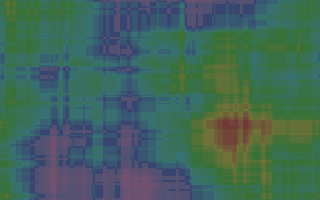29 byte DOS intro called fr29b
When going back down memory lane about my programming projects the first memory that comes up is developing software under DOS. The simple way of writing programs as .com files allowed for a lot of fun stuff like coding size competitions. Those executable files did not include any header and got executed as code starting from first byte of the file.
My favorite production of the old days is this 29 byte small intro that I developed 2001 using assembly language. It did fit into the 32 byte intro competition of the 0a000h demo party 2002 and won the first place.
org 100h ; tell nasm that this program will be loaded at 0x100 address
mov al, 13h
int 10h ; set 320*200 graphics mode with 256 colors
lds bp, [bx]
next_box:
rdtsc ; read time stamp counter
xchg ax, di ; use it as random offset to VGA buffer
mov cl, 8ch ; use a 140*140 box
next_line:
mov bl, 8ch
next_pixel:
inc byte [bx+di] ; increase color index in this box
or byte [bx+di], 80h ; ensure upper bit is set
dec bx
jnz next_pixel
add di, 140h ; add 320 = point to next line
loop next_line
jmp next_boxIf you want to assemble it yourself into a .com file, download nasm, save the code as fr29b.asm and execute this command on a shell:
nasm -f bin -o fr29b.com fr29b.asmTo run DOS programs on a system that doesn’t include a DOS subsystem (Like Windows Version up to Windows XP 32 Bit did) you should get DOSBox. If you run Windows Vista or later, open “Control Panel\Default Programs\Associate a file type or protocol with a program”, scroll to .com file extension and then set the installed DOSBox binary as default program for this file type. Now you are able to execute .com files directly in an emulated and safe environment on your machine.
The algorithm behind the plasma effect is quite simple. At a random offset on the screen i increase the color index of a 140 pixel *140 pixel box that starts at this random offset. You can increase or decrease the size of the box and you will get a slightly different looking effect, but in my tests I preferred the one using 140. If the random offsets starts near a line end, drawing over the end of the line will draw on the beginning of the start of the next line. Looking at the default VGA palette you will notice that the first 16 (CGA compatible) colors don’t fade nicely into each other when we just increase the palette index in memory for those. To circumvent this problem i make sure that the highest bit of each pixel (which represents an index to the VGA palette) is always 1, so that increasing random pixel will just rotate the index to the palette in the range of 128 and 255.




If you are unfamiliar with the lds trick at third code line, let me explain it: The lds instruction will load a pointer into ds and the register specified as argument. On startup of a DOS program the cpu register bx is 0, therefore the instruction “lds bp, [bx]” will load the 2 bytes at memory address 0x0000 into bp and the following 2 bytes at address 0x0002 into ds. The com file will get loaded at offset 0x0100 by the program loader, the 0x100 bytes in front of that memory contains the Program Segment Prefix.
Looking at the meaning of the first values you can see that bx will contain the opcode of the int 20h instruction and ds the memory size in paragraphs. The memory size in paragraphs is usually 0x9fff and only 1 number and therefor 16 byte off (1 paragraph represents 16 byte) of our desired 0xa000 address which represents the VGA memory segment.